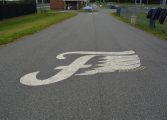I like the effect of cutting a window in a dense hedge to frame something distant in the landscape; different scenes are framed depending on where the viewer is standing. There are some examples at
Oatlands outside of Leesburg and the governor’s mansion in Williamsburg has a nice hedge maze.
One of the best topiary collections is in Monkton, Md. at Ladew gardens and the largest most elaborate display is at Longwood gardens outside of Philadelphia.
You can enjoy clipping some topiary yourself. Use a form and let the plant grow to the edge. Then keep it clipped to follow the shape of the form. Lewis Ginter Gardens in Richmond has some fine large examples done this way. I have tried to form a chicken with some privet but I admit it looks more like a rabbit.
Tabletop topiaries are available made with English ivy or jasmine where the climbing tendrils follow a form. A coat hanger can be bent into a circle with the hook straightened out and stuck in the soil. A wreath wire base can also be used, sticking part of the wire ring into the soil, held in place with a landscape pin. Small azaleas also lend themselves to topiary as they sprout from each cut, making a dense evergreen. Clip after the bloom for the most growth. Rosemary does well when clipped and is often seen as a tower of balls graduating in size. I am growing two dozen rosemaries to plant along a three foot high wall built to hold plants in the top 10 inches. They will be planted one foot apart and when they grow into a hedge, it will be clipped into shape.
I have several home grown topiaries. One is made with Carolina jasmine on a row of wagon wheels. It is a prolific climber and much clipping is needed to keep it tidy. I’ve made a peace sign with pyracantha against a barn wall using wire and nails to make the form. Pyracantha looks good clipped tight. When it blooms, it is lovely and when it produces berries, it is fabulous.
English boxwood holds form well but it is such a slow grower that it takes a while for the figure to be seen. Often small ornamental trees are limbed up to a height of four of five feet, then allowed to branch out and clipped to form a ball. Jasmine, lantana, and roses are often used to make these ‘lollipop’ topiaries called ‘standards’. If you use autumn clematis, it will become so wild that the form may be obscured, so choose a form which will show off the bloom at its wildest. One friend has a clematis which she calls the ‘whale’ when it is in bloom on her fence. With some pruning she could make the blow hole spew plumes of little white flowers.
The most extensive home project I’ve seen is a garden pattern where the house, with a circular drive surrounded by bright yellow dwarf chamaecyparis is the sun and throughout the garden are various shrubs pruned into balls which represent the planets of our solar system. Mercury is a dwarf blue spruce nearest the house. Venus has some autumn clematis over it, the earth is covered in vinca, Mars in red sedums. Saturn is an abelia with shiny metal rings and Jupiter is a barberry with nine small orbs on sticks around it and 1 red species tulip which pops out of the side every spring. Neptune and Uranus are similar with blue violas stuck in pots around their equators and Pluto is a tiny English boxwood out at the edge of the woods.
I will try again with the privet. It is a good plant to experiment with as it is a dense evergreen with constant new growth. I have a nice form made of chicken wire and by mid-summer, I hope it looks like an animal of some kind. Maybe by next winter, it will appear to be grazing on the frosty lawn.




